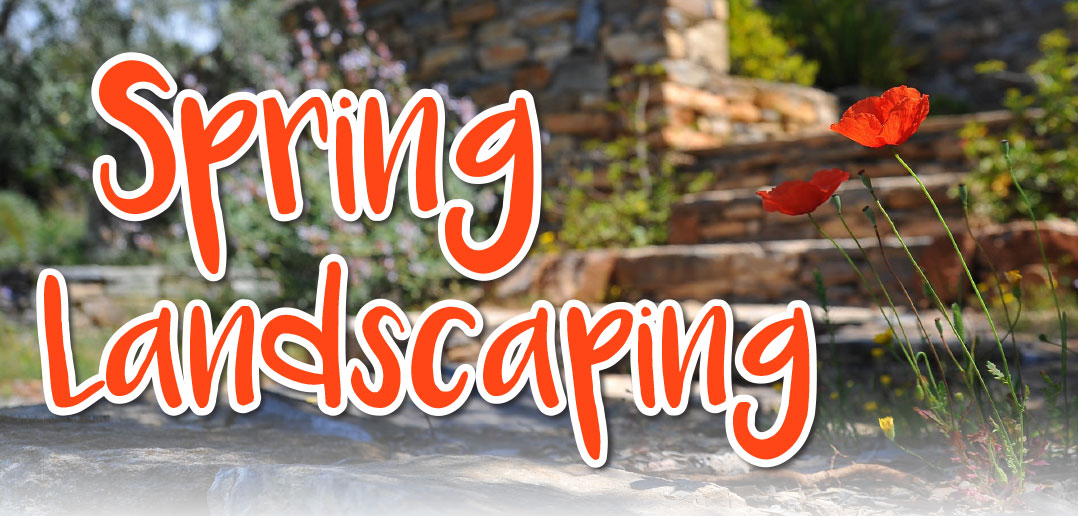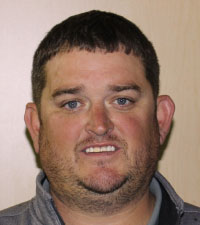Spring Landscaping
As yards finally turn green and trees begin to bloom, it’s time to get our lawns in order for the spring. Plus, with all the time we are spending at our homes now, this is a perfect opportunity to start on all the lawn care, landscaping, and decorative projects you’ve been meaning to do in order to make your yard look its best.
To get the most use and enjoyment out of your lawn, you will need the right maintenance knowledge and tools before getting started on any projects. Turn to the experts for help!
Cleanup
The first step towards any landscaping goal should be a thorough cleaning of the property. Your lawn will need to be cleared of all leftover leaves and debris from fall and winter. Be careful of any perennials or bulbs that could be hiding under the leaves—you don’t want to damage or pull them out by accident. Some plants may already be making an appearance, but it’s the ones that haven’t sprouted yet that you need to be wary of. For trees and shrubs, prune away winter-killed branches to make room for new growth. At home, these projects are pretty quick and simple to complete on your own. For commercial properties with large landscapes, it’s best to hire a lawn maintenance company that is equipped to take care of the cleanup.
1776 Grounds Maintenance offers year-round commercial grounds keeping services. Spring and fall cleanups are a service they regularly complete to help property owners get over that first boundary keeping them from a beautiful yard. Their crew makes sure to take the appropriate amount of time to complete every job to ensure that nobody gets injured, nothing gets destroyed, and the work is done precisely and efficiently to guarantee a clean and healthy lawn.
Healthy Lawn Practices—Mowing, Watering, Aerating
It’s important to establish a healthy lawn as the base of any landscape. After all, no matter how much money you invest on retaining walls, perennials, trees, etc. your lawn won’t be at its best without a strong, fertile foundation. Owner of TDK Lawn Care, Lee Schumacher, taught us some of the most important steps to take to ensure a healthy lawn.
“Spring is an important time if you want your grass to build up the strength to survive a potentially blistering summer,” he said. “One of the biggest mistakes I see people make is cutting their lawn too short. Mowing at a proper height is the best way to keep your lawn healthy. I personally keep my mower set at 3 1/4 inches year round, but keeping it anywhere between 2 3/4 and 3 3/4 inches is fine. Taller grass chokes out weeds and helps your lawn maintain moisture, which will help it prosper during hot summer days in Nebraska. Watering correctly and proper lawn nutrition are important too. Water levels depend on the type of grass and its environment, but a good rule of thumb is adding one inch a week, depending on weather. Aerating is also important. Lawns can be finicky, so if you want one that’s always thriving, come to the professionals. We can give your lawn all the nutrients, water, and services that it requires, while also training it to become more efficient and hardier.”
Lawn aeration does wonders in loosening the soil so that water, sun, nutrients, and fertilizers can get to the roots. Larry Svoboda from Ray’s Lawn and Home Care told us what to look for if your yard needs aerating.
“If your lawn is a high traffic area, you’re probably a person who should be aerating their lawn,” said Larry. “When soil gets compacted, it inhibits the flow of the essential air and nutrients that support a thicker, healthier lawn. Soil compaction could be caused by children playing, animals running on it, or even if you simply like to entertain outside. An easy way to tell if your lawn may need aerating is to watch and see if rainwater puddles in places where it used to be absorbed. A common myth about aeration is that it will ruin your herbicide barrier, when in reality it doesn’t affect crabgrass control or weed prevention at all. While aeration machines can be rented and it’s possible to do it yourself, it can also negatively impact your lawn if done incorrectly or if it doesn’t need it done. If timed improperly, it can stress out your lawn very easily. Never aerate a dormant lawn. We always recommend having professionals come to check the health of your lawn in terms of nutrients, water need, and soil density before starting any larger lawn projects.”
If there are areas of your grass that have turned yellow and died, then you should consider overseeding them after aeration. Aerating opens up the soil and provides a good surface for seed germination. Spring overseeding is best done between April 1 and 30 for Kentucky bluegrass and between April 15 and June 15 for tall fescue. Overseeding will allow fresh grass to grow and re-establish a strong root system. Make sure that your sprinkler system is up and running so that you can properly germinate your new grass.
Preparing Your Irrigation System for Spring/Summer
A large project that irrigation specialists take on every season is preparing irrigation systems for the upcoming growing season. Heroes Lawn & Landscape, a Heroes Management Services company, recently added irrigation management to their extensive list of lawn maintenance services.
“We now provide complete start-up/shutdown packages for clients’ irrigation systems,” Roy Dos Santos, head of the irrigation division at Heroes Lawn & Landscape, informed us. “Each startup package includes a system test, 35-point inspection, adjustment of all sprinkler heads, and programming the controller for the season. Each package is unique to the clients’ property, with discount prepayments available as well!”
When setting up a system after a winterization period, it’s important to do it correctly in order to prevent damage to the system. Here are the main steps you should take:
- Prior to pressurizing the system, check your backflow device for damage
- Never open the water too quickly to avoid damaging your mainline or valves
- Inspect each zone and fixed nozzle for possible wear and tear, obstructions, and other damage
- Check to see where each nozzle is spraying, and make sure not to waste money by spraying sidewalks or driveways
Once these components have been taken care of, it’s time to program the controller so that the water flow rate does not exceed the soil’s absorption capability. Jeremy Hunt with Hunt Irrigation is very familiar with the local conditions, so he gave us some guidance.
“The soil in Lincoln and surrounding communities is mostly clay,” Jeremy noted. “This means the water absorbs slowly and evaporates quickly. Therefore when programming your controller, it is best in this area to program shorter run times and multiple start times. Most controllers are capable of handling three start times. A good start time schedule would be 1 a.m., 3 a.m., and 5 a.m. Scheduling a two-hour break or rest between operations will allow the water enough time to absorb into the ground and reduce run-off.”
Jeremy recently completed training on Watertronics’ WaterMax line of horizontal centrifugal pumps and their proprietary well drive systems, making Hunt Irrigation an authorized service and pump start-up company for Nebraska. The WaterMax series provides self-enclosed pumping solutions for varying irrigation needs ranging from small scale condo projects and lake homes to larger commercial, golf, and athletic field applications.
Outdoor Equipment
Many people already have trusted professionals that they work with while others are in the market for lawn assistance. No matter your circumstance, make sure that you speak with lawn care professionals ahead of time on how you want your lawn to be serviced. Be sure to cover all the bases by speaking up about your preferences and concerns in an upfront manner. You want to make sure that nothing is assumed and you are all on the same page.
If you’re already familiar with how to keep your lawn healthy and prefer to tend to it yourself, AKRS Equipment has all the lawn equipment that you could need. Nick Wessel, a turf and commercial equipment sales professional at AKRS Equipment, gave us a quick debrief on what their company offers.
“AKRS Equipment is a full service dealer with parts, service, and sales on John Deere and Stihl equipment,” he said. “We offer a Ready-to-Mow service where we come to you to service your equipment. That way, your machines are ready to go when you are. It’s always suggested to service your equipment before the spring season begins.”
If you are unfamiliar with how to service your lawn mower or other John Deere or Stihl equipment, you should refer to a professional to make sure that you don’t accidentally damage your own equipment. For example, many people sharpen their mower blades to be extremely sharp, but they should actually be maintained to the original bevel edge. If they are razor sharp, the sharp edge will roll over and dull quickly. It’s recommended to keep your blades at a .40 millimeter (1/84 inch) cutting edge or less.
Common signs that you should see a professional about your equipment include:
- Poor cut quality
- Leaving a trail of cut or uncut grass
- Grass clumping
- Poor bagging performance
- Uneven cut
Landscape Design
Other than lawn quality, there are many other aspects of landscaping that can affect how people (including yourself) see your lawn. Between softscapes and hardscapes, you can really transform your outdoor space.
“Unfortunately, there are many people who have convinced themselves that they cannot have a beautiful lawn for one reason or another,” Jackie Lienemann from Luxury Landscape addressed. “One common reason is that homeowners convince themselves that if their lawn is small, they don’t have room for a beautiful outdoor space. That is not the case! Actually, it’s the opposite of the case. We have a lot of experience in designing smaller areas that will give the maximum usage without looking overdone. When you utilize the knowledge of a landscaping professional, you’ll learn all the dos and don’ts when it comes to planting. You don’t want to plant too much and have an overgrown jungle a couple of years from now when the plants have matured.”
Jackie also told us about some current landscaping trends that she’s been seeing lately: “More than ever, our customers come to us looking for something totally unique, a landscape that doesn’t look like their neighbors’. That’s why every design we complete is individualized and different. There are so many new hardscape (pavers, blocks, caps, etc.) products coming out this spring that we’re super excited to start using this year!”
While you may think you need exotic plants to make your yard look unique, there are actually a large variety of Nebraska-native plants that are just as beautiful as non-native plants. Using native plants ensures that your garden will thrive even through Nebraska’s crazy weather. They also require less watering on average and no chemical fertilizers and pesticides because they’re adapted to the environment, unlike their foreign competitors. Natives also make better environments and food sources for pollinators, especially those that migrate! Exotic plants can sever the food web of your ecosystem and even become an invasive pest.
Plants and Perennials
To emphasize how important it is to plant local, research by the entomologist Dough Tallamy found that native oak trees support over 500 species of caterpillars, whereas ginkgos, a common alternative native to Asia, host only five species. If you want beautiful butterflies and moths to visit your lawn, it’s important that you provide plants that they can interact with.
Here’s a list of native-Nebraska plants that could liven up your garden:
- Purple Poppy Mallow
- Blackeyed Susans
- Coneflower
- Beardtongue
The easiest way to make your yard look unique is by using a variety of flowers. Jessica Jasnoch from Earl May told us the best ways to incorporate vegetation into your yard.
“Using a variety of plants is the best way to ensure that your plants stay healthy and colorful,” she said. “By adding more diverse flowers in your garden, you’ll be helping a declining pollinator population. If you want your plants to be successful, you’ll want to take actions to make sure your ecosystem has the resources that it needs to thrive. Planting perennial blooming plants with staggering bloom times will keep your garden colorful all season long. Also, the diversity of flora protects your plants from being wiped out by disease or insect issues. People sometimes shy away from ‘messy’ plants that shed berries or seeds, but they actually invite pollinators to come visit your yard! And those pollinators will be a natural improvement to your environment for generations after this spring since most flowering plants require pollinators. As an added bonus, they are a great way to teach your children to appreciate nature and understand ecosystems!”
An easy pollinator to attract is birds. The bird population booms in the summer as they come back from migrating, so they can put a lot of stress on their natural food resources. Setting up bird feeders in your yard is an easy way to have a positive impact on your local ecosystem. Here are some more easy steps you can take to attract pollinators to your yard:
- Provide local, native food sources for insects
- Provide clean water
- Leave some nesting sites like soft dirt, hollow branches, and holes in wood
- Reduce or eliminate insecticide and herbicide use
Trees and Shrubs
When planting, it’s important to consider the plant’s mature size, intent, and function, which relates to the level of maintenance it will require. Working with a landscaping professional will help you navigate these questions. Eagle Nursery is a full-service nursery, landscape, installation, design, and maintenance facility with 70 acres of growing fields. They are proud to utilize Nebraska-grown trees, shrubs, and perennials.
“The level of care for your basic garden plants versus more serious landscaping investment-type plants is not the same,” Tom Scharfen, owner of Eagle Nursery, told us. “For example, most trees will require trimming every growing season to avoid fall growth spurts and desiccation burn, while most perennials will not require deadheading (removal of dead flowers) to re-bloom. Make sure you consider the level of maintenance you’re willing to complete when deciding what to plant.”
“The best time to plant trees is during their dormant period, typically early spring or late fall. Trees really are lifelong investments for your property, so it’s important to give them all the resources they require to grow,” Tom added.
Unlike flora, shrubs and trees can be trickier to plant and raise, so it’s highly recommend going to a professional with larger plant purchases and plantings.
There are many factors that affect tree health—how well suited it is to the planting location, proper planting, follow-up care, soil type, etc. Getting your tree to mature to its full size will provide you with environmental and economic benefits throughout its lifetime. Determining where to plant a tree is not a decision to be taken lightly, and it is definitely recommended to consult a landscaping professional before starting the long process. Tree growth must not interfere with underground or overhead lines. If you accidentally plant a tree too close to your house, you’ll be kicking yourself in the future when falling branches cause property damage or roots interfere with pavement. Proper selection and placement of saplings will help you to improve the appearance of your landscape while also guaranteeing that the tree will not cause you any safety concerns or financial losses.
According to research conducted by the USDA Forest Service, energy savings, storm-water runoff reduction, cleaner air, and higher property values lead to trees producing three times more of an economic advantage than their cost. Each large front yard tree adds approximately 1% to the house sales price. Additionally, strategically-placed trees can also help house owners save up to 56% on annual air-conditioning costs.
Outdoor Structures
Early spring is the perfect time to start on those larger, architectural landscaping projects. Whether you simply want to add stonework to your garden or want a new deck, there are many ways to add structure in your landscaping. Outdoor living spaces like patios, pergolas, and water features are extremely popular landscaping projects. That’s why it’s important get into contact with professionals as soon as possible so you can secure a place in their busy schedules.
Decks Unlimited takes pride in the projects and the relationships they build through every job. If you’re thinking of adding a patio or deck, we highly recommend stopping in to their new showroom to see all the options for design and resources.
“We at Decks Unlimited specialize in building dream decks that blend well with landscapes and surrounding features,” said Dan Waters, owner of Decks Unlimited. “It is important to us to design your deck so it looks intentional as if it’s always been there. Pergolas are also a beautiful addition to your backyard space. With all the new materials on the market there are a lot of options. Cedar is a beautiful natural option but keep in mind the maintenance of staining or sealing every few years. Heartland pergolas is a vinyl-wrapped aluminum pergola that we use outside of the traditional cedar pergolas. For decks, using the right product and the right colors mean everything. Timbertech is the best quality product on the market and offers a wide variety of colors and comes with a 25-50 year fade and stain warranty. Timbertech composite has a mold guard infused within the product, which for those high traffic flow to the ground areas is very important. We use #1 treated ground contact YellaWood ® lumber for our substructure. It’s important to make sure you’re using quality products so your new back yard space will be around for years of enjoyment, not years of maintenance.”
As Dan said, material matters when it comes to building outdoor structures. Aluminum has become a hot trend nowadays for its style and functionality. The new local expert in aluminum builds is Knotwood Central.
Not only is Knotwood aluminum beautiful, it’s also very eco-friendly. Metal is one of the most recycled materials on the planet, and aluminum boasts one of the highest recycling rates of any metal. Knotwood is 100% recyclable. Knotwood also uses VOC-free coatings and lead free finishes, leaving a smaller environmental footprint. The material is stain and scratch proof, corrosion resistant, light weight, and easy to install.
“By utilizing Knotwood aluminum with its real-wood appearance, you can have the beauty and warmth of wood without the time-consuming maintenance and expense,” Perry Gillaspie from Knotwood Central explained. “Aluminum doesn’t absorb water or moisture, so it won’t warp and expand when exposed to extremely cold temperatures. It’s also impervious to insects, so no need to worry about termites or ants. We offer battens, fencing, decking, privacy screens, shutters, railings, and balustrades. Knotwood is known for its extremely clean look when used in fencing and shades. Planter boxes designed with Knotwood are stunning and durable. We also create beautiful pergolas that are a staple in any landscape design. But they don’t just look pretty! Pergolas add shade to escape the heat and aid other lovely landscaping plants like flowers, vines, and ivy. Plant them at the base and they’ll weave themselves up the beams, creating a stunning visual effect.”
Metal as a gardening tool may once have been the well-kept secret of many professional landscapers, but recently it’s grown in popularity among amateur home gardens. Slim metal linings create a clean separation between grass, paths, and garden beds while keeping migrating materials like mulch and gravel in place. Also, metal edging is more able to be recycled at the end of its life. It’s stronger than plastic or wood, so it will likely stay in place for a long time. Steel edging is extremely popular because of its strength, durability, and flexibility. With clean lines and minimal intrusion on the vision you’ve created, it also won’t rot or become brittle in the cold. You can easily reshape it if you want to change the setup of your landscape as well.
Another way to create more order in your yard is to use a retaining wall on any slope with a run-off soil problem. Retaining walls provide the following:
- Functional support for keeping soil in place
- Prevention of sink holes and flooding
- Reduced yard maintenance and erosion prevention
If your yard would benefit from more flat and usable land, less rainwater runoff, or more seating (low retaining walls can also act as benches), then you should strongly consider a retaining wall. Not only are retaining walls extremely useful, they can also be beautiful. When installed by a quality professional with high-grade stone or brick, they can greatly improve the value of your home. Yankee Hill Brick has a wide selection of bricks that are all created in their high-temperature firing kiln.
Retaining walls are strong and functional, and they can also be decorative. An easy way to blend hardscape and softscape is to grow creeping vines on your retaining wall.
Social distancing doesn’t mean you can’t walk outside and take a breath of the fresh spring air. Use some of the extra time you have on your hands to make your yard healthy and beautiful, and don’t forget to call the experts for help!











